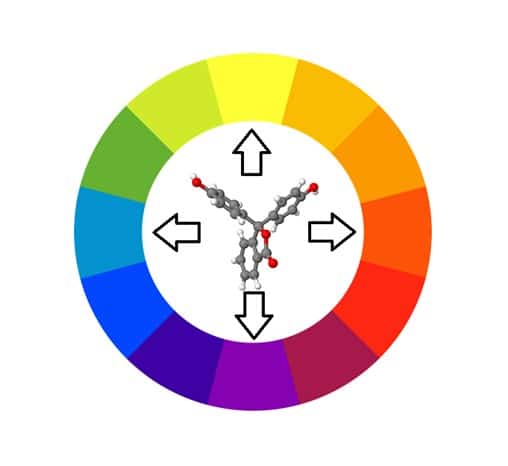The Magic of Colour
20 Jan 2021|Joseph Prentice
- Research

One of the first things we notice when we see something, such as a new material, is its colour. Initially, you may think that the colour is unimportant compared to other properties – perhaps strength or electrical conductivity – but the way a material interacts with light is often incredibly important; one obvious example would be solar cells. The question could then be asked: can we control how a material interacts with light? The fact that some materials change colour depending on their environment gives us a way to do this, and opens up possibilities for applications.
To the casual observer, colour is one of the most obvious properties of a material. What is perhaps not so well-known is that there are some materials, particularly molecules, that almost magically change colour in response to their environment. pH indicators are one familiar example, but there are many others. Some molecules exhibit ‘solvatochromism’, where dissolving the molecule in different solvents gives different colours. An extreme example is shown here (the compound is Brooker’s merocyanine) – you can see that basically the whole rainbow is included!
There are also molecular crystals that exhibit ‘colour polymorphism’, where the same molecule, packed together in different ways, produces completely different colours. A well-known example is commonly called ‘ROY’ – a molecule, not a person! – which gets its nickname from the fact it can be Red, Orange or Yellow, depending on how it is crystallised, as shown in the picture.
Knowing that such materials exist, the question is then: can we find more? This is not a purely academic question, as a material which changes colour controllably and in the right way could have many applications, for example in sensors, or even tunable lasers. There are many many molecules that could potentially exhibit colour-changing properties, so this will be a tough search. Making candidate molecules in real life in the lab is the ultimate goal, but doing this is likely to be a complicated and expensive process that we would like to avoid doing too often. Instead, it would be a huge help if we were able to narrow down the field ahead of time by predicting the colour of molecular materials accurately and relatively quickly.
As you might expect, this is quite a tricky problem. It requires solving the most important equation of quantum mechanics – the Schrödinger equation – for all the electrons in the material simultaneously. This would be completely impossible to do by hand! However, if we make some carefully chosen approximations, and enlist the help of (super-)computers to crunch the numbers, we can reduce the problem to a manageable size. What approximations we make will determine how accurate our answer is, and also how long it will take a computer to run the calculation. Typically, if you want your calculation to be more accurate, it will take longer – sometimes much longer.
So can we now predict the colour of a material accurately? There’s one further complication – it’s not enough to include one or two molecules in our calculations, as interactions between distant molecules will have a subtle but important effect on our answer. Including more molecules means including more electrons, making the calculation much more complicated and expensive. If we want a calculation that is not unfeasibly long, we can either include these interactions, or use a highly accurate method – not both.
My collaborators and I have been working on a method that can solve this quandary. The essential idea is to use a cheap method to do a calculation including many molecules, and then use both the cheap method and an expensive method to do a calculation including only one or two molecules. If we compare the results using the two methods for the small calculation, we can make a good guess at how wrong the cheaper method is, at least for the quantities we are interested in. We can then use this knowledge to apply a correction to the results from the large calculation. This allows us to include both the long-range interactions and the higher accuracy of the expensive method, but without having to actually do extremely expensive calculations! Our results have shown that this method works very well in a variety of materials, including ROY. With this method, we hope that predicting the colour of materials accurately will become much easier than it was before, allowing many more magical colour-change materials to be discovered.
Category: Research
Author

Joseph
Prentice
Joseph Prentice did his undergraduate MPhys degree in Physics at University College, Oxford, conducting his final year MPhys project under the supervision of Dr Amalia Coldea. He then moved to the Cavendish Laboratory at the University of Cambridge to do a PhD in computational condensed matter physics, under the supervision of Professor Richard Needs, funded by the EPSRC. His thesis, completed in 2017, was entitled ‘Investigating anharmonic effects in condensed matter systems’, and was awarded the IoP Theory of Condensed Matter Group “Sam Edwards” Thesis Prize in 2018. Whilst at Cambridge, he was (coincidentally) a member of St Edmund’s College. Following this, Joseph became a postdoctoral research associate at Imperial College London, funded by CCP9, and dually affiliated to the Departments of Materials and Physics, working with Professors Arash Mostofi and Peter Haynes. During this period, he also served as a part-time computational science specialist for the two departments.